|
What to bring to a gun class
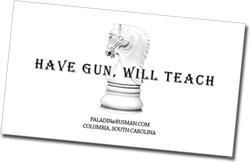 Handguns
Handguns
Long Guns
Ammunition
Ear and Eye Protection
Food and Drink
Clothing
Holster and Belt
We hold South Carolina CWP,
Florida CWP, personal protection, and
other firearms classes at convenient locations throughout
the greater Columbia, SC, area. They're always an
easy drive from Columbia, Sumter, and everywhere else in
South Carolina's midlands. Because our classes are near
major highways and airports we
attract residents of states such as New York, Florida,
and Georgia as well as people from throughout
South Carolina who want a South Carolina or
Florida Concealed Weapons Permit (CWP), a Basic Pistol
certificate, and world class training in personal protection
for civilians.
Don't let distance discourage you from taking any of our classes.
No matter where we hold your class the
following is dictated by our dual concern for your
success and for your safety—and for our safety and everyone else's too.
Firearms safety is our foremost
concern and is never negotiable. Our web site
is recognized internationally for
its major section about gun safety. We hope
you'll benefit from it even if you never take one of our
classes and even if you're not a gun owner. We're all in
this world together.
Although other instructors have their own preferences and we won't
speak for anyone else, we wouldn't be surprised if you found
that our core recommendations help you in classes held
by the best
instructors everywhere.
So what follows is intended to ensure your success and your
comfort consistent with our own concern for gun safety. We want you to succeed and to enjoy
your experiences with us. We know you're likely to practice
what you enjoy. Very smart people have been using
firearms for purposes including both recreation and self-defense
long before there were people who tried to tell others it
was wrong to do so. Of course everyone needs to be safe
around any potentially-dangerous mechanical device like
a firearm, which
is why we focus on gun safety throughout our
classes and in explaining what to
bring to them.
First, you need to know that students may not bring
firearms or ammunition into a classroom. Student firearms brought to a
shooting bay must be safe, unloaded, and either cased
or in a bag or other appropriate container. Bring only safe,
unmodified, perfectly functioning guns that you
yourself can
shoot. If you aren't sure that you can shoot your own
gun it would be a good idea to arrange for
Personal Training
with us before you take a class with other people who
need attention too.
Second, you must recognize that we're not gunsmiths and can't check
every gun, nor can we repair your gun if it does
not function properly, but
we will not allow one that seems unsafe to us. It's your responsibility to make sure that a gun you bring to class actually works as it should.
Third, keep in mind that the following covers general matters. When there are specific requirements or suggestions for
a particular class we tell you and/or email them to you before the
class.
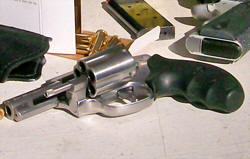 Handguns.
If you already own a handgun you intend to carry concealed
we'd like you to use it in class so you get as much as possible
from that class. Either a double-action revolver
or a semi-automatic pistol in a self-defense caliber is
good. Handguns.
If you already own a handgun you intend to carry concealed
we'd like you to use it in class so you get as much as possible
from that class. Either a double-action revolver
or a semi-automatic pistol in a self-defense caliber is
good.
No single action revolvers, derringers, target, plinking,
or novelty guns, and no .25 or .50 caliber guns.
No
.22 caliber semi-automatic pistols: they tend to
be fussy about ammunition, jam during shooting
qualification tests, and require everyone else
to wait while their shooters constantly fiddle with them
or require assistance to get the gun running. A .22 caliber
double-action revolver is a useful practice
tool but it's not ideal for self-defense and rarely
makes sense in this kind of class except,
possibly, for some people with handicaps that
prevent their use of other handguns.
No Hi-Point, no Lorcin, no Standard Arms, no Jennings,
no Bryco,
no Jimenez Arms, no Charter Arms, no Rohm, no
AMT .380 Backup. No junk. No exceptions.
If ever you are tempted to buy cheap because you
don't yet know enough to assess real value for
yourself, keep in mind the following known as
the Common Law of Business Balance. It is
especially appropriate to firearms and to
firearms training too:
“There is hardly anything in the world that
someone cannot make a little worse and sell a
little cheaper, and the people who consider
price alone are that person’s lawful prey. It’s
unwise to pay too much, but it’s worse to pay
too little. When you pay too much, you lose a
little money — that is all. When you pay too
little, you sometimes lose everything, because
the thing you bought was incapable of doing the
thing it was bought to do. The common law of
business balance prohibits paying a little and
getting a lot — it can’t be done. If you deal
with the lowest bidder, it is well to add
something for the risk you run, and if you do
that you will have enough to pay for something
better.”
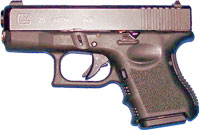 If
you don't already own a suitable handgun we can lend you one of ours
if you arrange the loan with us in advance and pay us for
the ammunition in class before you use it. If you use our
gun you must use ammunition we provide for it.
(Of course you pay us for the ammunitiion.) It's a safety issue. We
want our guns used with ammunition we ourselves would
use. If we lend you a handgun we'll lend you a belt holster
for it too but you must wear your own 1-1/2" wide
sturdy belt to use with it. (1-1/2" is not 1" or
1-3/4".) If
you don't already own a suitable handgun we can lend you one of ours
if you arrange the loan with us in advance and pay us for
the ammunition in class before you use it. If you use our
gun you must use ammunition we provide for it.
(Of course you pay us for the ammunitiion.) It's a safety issue. We
want our guns used with ammunition we ourselves would
use. If we lend you a handgun we'll lend you a belt holster
for it too but you must wear your own 1-1/2" wide
sturdy belt to use with it. (1-1/2" is not 1" or
1-3/4".)
We don't have belts or other
clothing to lend. When you bring your own gun you need
to bring your own holster for it too. The unavailability
of a suitable holster for a gun is a clue
that it would be wise to get a different gun. Be sure to
read our comments on
Holster and Belt below.
Top of Page
Long Guns.
Not every class involves the use of a "long gun" (a shotgun
or rifle). If you're taking a class that requires a long
gun bring the kind of shotgun or rifle that is appropriate
for the class as we describe it. We're highly flexible in
such matters. We're not gun snobs. We want to train you
with the gun you'll actually use.
We offer personal protection shotgun
and rifle classes and we also provide personal training
in the defensive uses of shotguns and rifles. That's
what interests us: self-defense and personal protection
by ordinary people who recognize the responsibility to
care for themselves and their families.
You won't need a long gun in CWP, Basic
Pistol, Home Defense, Defensive Handgun, or Personal Protection classes. Those are
handgun classes.
Top of Page
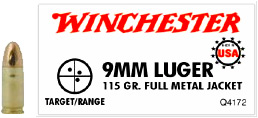 Ammunition.
Bring only fresh factory ammunition for the gun you use.
Read the gun, read the manual, read the box, and read the
cartridge case: they all should specifiy the same ammunition.
No reloads or handloads or "remanufactured"
ammunition: only factory new ammunition from
a major manufacturer such as Winchester, Remington,
or Federal. We're not fussy about the brand: those are just
examples. (Tip: When there's a choice between ammunition
labeled something like "Target" or "Personal Protection,"
choose "target" for use in class unless we say otherwise.
It's less expensive and works just as well on paper targets
as more powerful and more costly ammunition.) Ammunition.
Bring only fresh factory ammunition for the gun you use.
Read the gun, read the manual, read the box, and read the
cartridge case: they all should specifiy the same ammunition.
No reloads or handloads or "remanufactured"
ammunition: only factory new ammunition from
a major manufacturer such as Winchester, Remington,
or Federal. We're not fussy about the brand: those are just
examples. (Tip: When there's a choice between ammunition
labeled something like "Target" or "Personal Protection,"
choose "target" for use in class unless we say otherwise.
It's less expensive and works just as well on paper targets
as more powerful and more costly ammunition.)
All ammunition must be in factory fresh boxes as
purchased from the store. Don't bring old, corroded ammunition and
don't mix or repack what you bring. These
are safety concerns. Nobody does you a favor by telling
you it's okay to overlook potential problems with ammunition
that could hurt you or someone else.
Bring more ammunition than is required for any
class: that way you won't run short, can take advantage
of opportunities to practice, and return home with the
excess. Extra ammunition won't spoil and we want you to have a great experience
in class. We don't think anyone does you a favor by advising
you to bring only the amount of ammunition you're required
to shoot for qualification. For example, we think it's
unwise to bring only 50 rounds of ammunition to meet
SLED's
requirement that you must shoot 50 rounds to
qualify for the CWP: if even one of those rounds fails
to work you are in trouble. Bring 100 rounds to class
and take your unused ammunition home with you.
It's just like real life: you can't win
if you're unprepared. So right from the start we
teach you to be prepared and avoid unnecessary risks. We go far
beyond telling you the usual "be prepared." We
help you learn how to be
prepared. Don't try to game this system. Your life is at
stake.
Top of Page
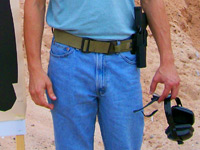 Ear
and Eye Protection. Bring good hearing protection
and good vision protection, and always wear them when anyone
is shooting on the range. Ear
and Eye Protection. Bring good hearing protection
and good vision protection, and always wear them when anyone
is shooting on the range.
Anyone shooting a firearm must
have and must employ good eye and ear protection.
Use them or suffer permanent physical damage. Consult
your own health care professionals for what
you need
to protect your health. We're not vision or hearing specialists.
-
We know from experience that
ear plugs (hearing
protectors you push into your ears) block useful sounds and prevent you from hearing instructors
and commands. That's not good on a shooting
range or in a class. If you can't hear us you
can't know what we're saying.
-
Earmuffs—even inexpensive industrial earmuffs
you can buy at stores such as Wal-Mart, Lowe's,
or Home Depot—are better and
more useful than ear plugs because you can lift them briefly when you know the instructors are giving commands.
Like ear plugs that kind of earmuff tends to
prevent you from hearing unexpected instructions
and other sudden information too.
-
Neither form of
"passive hearing protection" is as
useful as "active hearing protection" such as
electronic earmuffs. Electronic earmuffs
are most useful because they reduce the
intensity of gunshots while allowing nearby
voices.
The relative costs are about $1 for ear
plugs, about $9 for non-electronic earmuffs, and
about $60-$70 for basic electronic earmuffs.
When we talk about "earmuffs" in the context of
shooting we're talking about hearing protection,
not earwarmers.
We show you useful directions but it's up to you
to take responsibility for your own protection.
The student in the accompanying illustration is
holding a basic pair of protective earmuffs and
eye protection (as well as a useful combination
of belt and belt holster).
Top of Page
Food and
Drink. Proper hydration is essential in our
Southern climate, even during fall and winter. You should bring water to our classes and
drink frequently, but of course we can't parent you and
must rely on your own good sense. Bring lunch to CWP classes
and other classes that span lunchtime: there's no nearby
place to purchase lunch and no time to do it. (Tip: Feel free to bring other
snacks, especially health bars, but not chocolates or other
sweets. You don't want a sugar rush.)
Of course we do not
allow beer, wine, or other alcoholic beverages or intoxicants
in our classes, or on the shooting range, or in any
connection that might possibly affect a
participant's behavior.
You won't find us inviting you to "bring your
own bottle."
Top of Page
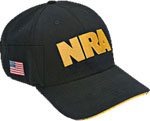 Clothing.
Dress appropriately for the weather and for a sandy environment
in the Columbia, SC area.
Men and women both should wear
long pants with pockets for spare ammunition, a shirt with
sleeves that can roll up, socks and sneakers or boots or
rough shoes, and a baseball type cap as additional protection.
(Tip: When you join or renew NRA membership through us in our class we give
you an NRA baseball cap that is perfect when shooting.)
The cap protects against trapping hot cartridges behind
your eye protection and shields your eyes from glaring
sun. Clothing.
Dress appropriately for the weather and for a sandy environment
in the Columbia, SC area.
Men and women both should wear
long pants with pockets for spare ammunition, a shirt with
sleeves that can roll up, socks and sneakers or boots or
rough shoes, and a baseball type cap as additional protection.
(Tip: When you join or renew NRA membership through us in our class we give
you an NRA baseball cap that is perfect when shooting.)
The cap protects against trapping hot cartridges behind
your eye protection and shields your eyes from glaring
sun.
In this climate we suggest that you dress in layers including a T-shirt so
you can adjust according to temperature and humidity.
Our
shooting bays are outdoors. An outdoor shooting
environment is superb when you know how
to adjust for conditions—better than an indoor
shooting range for
serious defensive training and much better ventilated too.
That's important when lead particles are in the air. We
shoot in all but the most extreme weather conditions. Check
your email the morning of a class: if you don't
get an email from us that morning calling a class off,
assume that the class is on.
Sweatshirts, pullovers, jackets, or anything else that can catch
a gun, dangle inside its trigger guard, or get in your way
are unsafe for classes. If a cover garment can't
tuck into your pants it must unzip, unbutton, or unfasten
so it is completely open while you're wearing a gun
and never conceals or hides or obscures or covers your
gun. We
must be able to see your gun when it's on your person or
in your hands.
No threatening or offensive slogans
on anything please. Do wear socks and don't
wear sandals: your feet must be protected from hot
shells. There are good reasons why experienced people who
shoot dress as they do. Personal safety is
foremost among those reasons.
Top of Page
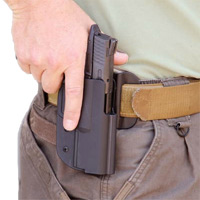 Holster
and Belt. These are safety issues, not fashion preferences.
Don't let anyone tell you otherwise. You
don't want to walk around dangling
an unholstered and potentially loaded handgun. You most
certainly don't want to be around other people who
behave that way. Holster
and Belt. These are safety issues, not fashion preferences.
Don't let anyone tell you otherwise. You
don't want to walk around dangling
an unholstered and potentially loaded handgun. You most
certainly don't want to be around other people who
behave that way.
It's not cool for anyone
to mishandle a gun and we're not
meanies for insisting on proper gun handling in our
classes. We're alive and uninjured and we have plans to
continue that way for many years to come. We practice
personal protection and we teach you to do the
same—starting right now. Don't hurt
yourself.
You do want to learn and develop skill in how to draw
from a holster and shoot in the event that it's
necessary for you to stop a deadly force attacker. In our CWP
and Basic Pistol classes we require a belt holster (also
known as an "outside the waistband holster") because those
holsters tend to be safest for people in basic classes.
We teach that your equipment should work for you. It must not
endanger you, other students, or us.
You also want a belt holster so that later you can practice
marksmanship and other basic skills without getting tangled
in more complex holsters used for concealment. You absolutely need a belt holster if you're taking the required training class
for a South Carolina CWP because SLED's shooting qualification
test for certification requires you to shoot a substantial
number of rounds after drawing from a holster. You can't
draw from a holster unless you're wearing the holster from
which you will draw.
Good holsters are made for specific handguns. Bring a
good quality belt holster suitable for your handgun
and make sure it fits both your belt and your gun perfectly before you come to class.
Don't bring a holster with a retention strap. No
retention holsters, inside-the-waistband, cross-draw,
shoulder, small-of-back, bellybands, Thunderware, ankle
holsters, pocket holsters, loops of string, clipdraws,
wallet holsters, or other novelty holsters.
We'd like you to practice what you've learned in class after
it's over and we know you'll enjoy shooting more with a
good quality belt holster and belt than with something makeshift
or some overly complex device
that is an accident waiting to happen.
 Your
belt must fit you, your holster, and the belt loops on
your pants. They form a system. The goal is for the belt to support your gun in your
holster without flopping or sagging. We ourselves usually wear
Original Wilderness Instructor Belts of the 5-stitch kind. We like
that belt 1-1/2" wide, which is the width required by holsters
we use. We get ours from
Lightning
Arms Sports (if you phone them ask for Craig or
Audrey and tell
them you were recommended by Paladin Services LLC in Columbia,
SC). We've found the 1-1/2" wide Original Wilderness
Instructor Belt (5-stitch) so comfortable that we often wear it
with sportswear. Your
belt must fit you, your holster, and the belt loops on
your pants. They form a system. The goal is for the belt to support your gun in your
holster without flopping or sagging. We ourselves usually wear
Original Wilderness Instructor Belts of the 5-stitch kind. We like
that belt 1-1/2" wide, which is the width required by holsters
we use. We get ours from
Lightning
Arms Sports (if you phone them ask for Craig or
Audrey and tell
them you were recommended by Paladin Services LLC in Columbia,
SC). We've found the 1-1/2" wide Original Wilderness
Instructor Belt (5-stitch) so comfortable that we often wear it
with sportswear.
If you're wheelchair bound or have some other relevant
medical disability we'll work out an appropriate holster
situation with you in class. We want you safe, capable,
competent, and successful. We enjoy helping.
Top of Page
Email us for more information and an application to attend any
of our classes. Please include your local phone
number so we can call you to answer your questions and get information
about what you need. We'll be happy to hear from you.
Top of Page
|